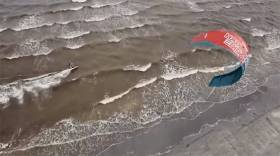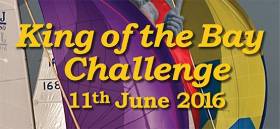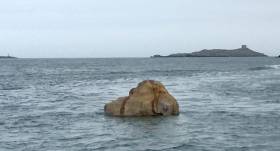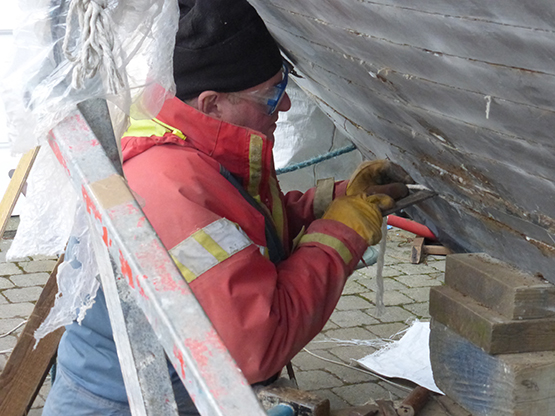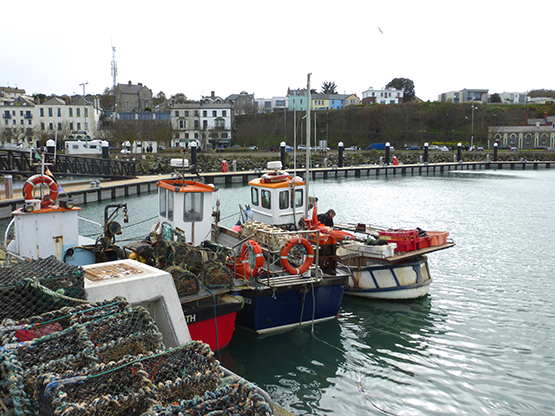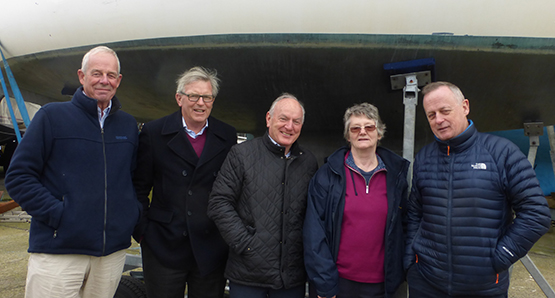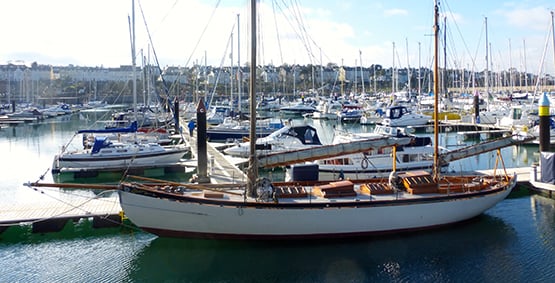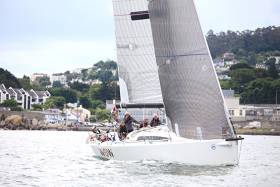Displaying items by tag: Dublin Bay
#DumpingRecordResponse - A record number of submissions to the Environmental Protection Agency (EPA) have been received in response to Dublin Port’s most recent application to dump spoil in Dublin Bay, reports Lorna Siggins of The Irish Times.
A total of 780 submissions from public bodies, non-governmental organisations and individuals have been received in relation to the €230 million Alexandra Basin redevelopment project.
The Irish Underwater Council warns contaminants could damage a special area of conservation (SAC) as previously reported on Afloat.ie in regards to Rockabill Dalkey Island.
The EPA said this was the highest number of submissions received on a dumping at sea permit application since it assumed responsibility for this function in 2010. However, it will not be holding an oral hearing on the application as this is not allowed for in the current legislation.
An Bord Pleanála has already approved the Alexandra Basin redevelopment. At an estimated cost of €230 million it has been described as the single largest infrastructural investment project in the history of the port.
It aims to facilitate larger cruise ships in the port, including a twin berth farther up the Liffey beside the former Point Depot (now the 3 Arena).
As part of this, Dublin Port plans to dispose of a large part of some 6.4 million cubic metres of material on the Burford bank 5km southeast of Howth, which is in a special area of conservation (SAC) from Rockabill to Dalkey Island.
For more The Irish Times has the story here.
#DublinBay - A motorway across Dublin Bay? City councillors are opposed, but State policy may make its construction inevitable, as Louisa McGrath writes in the Dublin Inquirer.
Proposals for a new stretch of high-capacity road running across or under Sandymount have been mooted for decades, with the current iteration put forward by the National Transport Authority (NTA) intended as a completion of the M50 as a ring road for the capital.
But it's prompted a stand-off with Dublin City Council, whose members recently passed nine motions to block any bypass connecting the Port Tunnel to the southern section of the M50.
They have modern civic planning – which prioritises public transport over more roads and congestion – on their side, not to mention the potential impact on South Dublin Bay communities, and the area's Biosphere status.
However, national policy has already been signed off in spite of such concerns, and the removal the bypass from the city development plan may even be in breach of the law.
As Green Party leader Eamon Ryan writes in today's Irish Independent, the situation is a "mess".
The Dublin Inquirer has much more on the story HERE.
#BattleForTheBay - All ages are welcome to Dollymount Beach on the north side of Dublin Bay today (Saturday 28 May) for the 10th edition of kitesurfing weekender the Battle of the Bay.
Doubling as the first leg of kiteboarding's KBC Tour, the weekend will also host contests for stand up paddle boarding - with the action even branching out to the River Liffey tomorrow morning (Sunday 29 May) for the Dublin Bay SUP Classic.
Plus as always throughout the weekend there will be food and entertainment on the beach, including kiting and SUP lessons for kids, as well as beach volleyball and land yachting demonstrations.
For more details visit the Battle for the Bay website HERE. And see below for some of the action from last year's event:
Radical new ideas are coming to the fore for next month's Dun Laoghaire Motor Yacht Club (DMYC) regatta. The Notice of Race just published outlines a “King of the Bay Challenge” open event. (Downloadable below).
In a change from the format over recent years, the DMYC has broken away from the combined clubs format which the DMYC considered to be a 'Dublin Bay “Deja Vu” race', and is offering a different format that it hope provides a novelty and encourage interest in to participation from the less competitive side of the sport. The emphasis is on 'fun and participation' with a less competitive element as the serious racers will be at Howth for the ICRA Championship.
The features of our format are, for cruisers;
· A costal race for racing cruisers based on standard Echo, which disregards the personal performance of the crew and gives the more accomplished a chance to use the boat driven handicap.
· A costal race for non-racing cruisers, when DMYC awards handicaps, if there are none available.
· A sheltered costal race for the sports boats based on the DBSC Sports Boat handicap scheme
For Dinghies:
DMYC plan to run a pursuit race, for all monohull dinghies of approximately 100 minutes, a tortoise and hare type format, with the first home being the winner. Then DMYC will run a “frostbite” type handicap race divided into fast and slow boats. This format is successfully run in the UK, for events like the Tiger Trophy at the Bloody Mary SC.
As further encouragement DMYC are setting the entry fee low, with a late cut off, with a fully online entry system, for convenience.
The aim is to avoid class starts with only a handful of competitors, and give everyone a day on the water and someone to race against.
A New Dublin Bay 'Rock' Appears off Dalkey?
Last season Dublin Bay sailors hit rocks off Dalkey Island prompting Dublin Bay Sailing Club, the largest leisure users of the bay, to issue a warning over the hazard. Known locally as 'Leac Buidhe', the rocks in Muglins Sound gave some sailors a bump at low water. As a result, sailors were warned to stay away from rocks at the North end of Dalkey Island. This week Afloat.ie has been sent a number of photos depicting a new 'rock' in a nearby location.
The mysterious appearance is nearly as amazing as last month's story on Afloat about the cruising boat that witnessed a volcano emerging in the Pacific. Except this time, Afloat has been reliably informed, the new 'rock' won't cause much of a bump because it is made of fibreglass and linked to a film crew based at nearby Coliemore Harbour! Realistic isn't it?
Howth Harbour Thoughts From Home
This weekend has the Irish Sailing Youth Pathway Championships being staged at Howth, and despite the weather the place is buzzing. From being a harbour abandoned in embarrassment for twenty years in the middle of the 19th Century, the peninsula port has gradually evolved to develop a vibrant balance between fishing harbour, sailing centre, and visitor magnet. Longtime local W M Nixon tries to tell it like it is in Howth when seen from the inside.
Howth has most of the advantages and few enough of the disadvantages of being an island. Head home eastward through the isthmus at Sutton Cross (and don’t forget you’re heading eastward - Howth is Dublin’s Eastside, while the Northside is in nearby Ireland), and you shed your Irish identity to become a Howth person. Ideally, this means you become a complete nobody among many other nobodies, for that’s the way we like it.
It must be some sort of defence mechanism, for there was a period in the middle of the 1800s when the powers that be in nearby Ireland preferred to forget our very existence. You see, when the vital links of government between Dublin and London were being maintained by special sailing packet ships, Howth was important because the island of Ireland’s Eye (even in this blog we haven’t the space to explain how it got its name), which is upwards of half a mile off the distinctly rough village, was able to provide an element of natural shelter at a time when Dublin Bay and Dublin Port tended frequently to be disaster areas for shipping.
There were times when the only shelter in Dublin Bay itself was in the very limited space inside Dalkey Island, where a sailing ship could easily be trapped, whereas Howth Sound inside Ireland’s Eye, while north of Dublin Bay and beyond the Baily, nevertheless enabled a potentially embayed ship to cut and run. And yes, that is how the phrase originated.

The north side of Dublin Bay in 1692. The Government’s cross-channel packet boats favoured the roadstead anchorage at Howth inside Ireland’s Eye as it provided better shelter than the exposed bay itself, yet there was more space to cut and run than could be found in Dalkey Sound
Thus they built an inn in the village so that people passing through to London, and waiting for the packet boat, would not impose unduly on the hospitality at Howth Castle of the St Lawrence family, unless they were awfully important. And then when the engineer Thomas Telford was commissioned to build a road linking London with Dublin through Holyhead, naturally on the Irish side he followed the official view of things and continued his road through Howth and on towards Dublin, in light of the fact that offical policy was that the Government harbour would be built at Howth.
And build it they did, from about 1807 onwards, with John Rennie in charge. But with the gathering prosperity and increased trade after the final end of the Napoleonic Wars in 1815, the movement for the improvement of Dublin port and the building of an “asylum harbour” at Dunleary within Dublin Bay gained traction, and by 1817 what would soon become the highly-fashionable Kingstown Harbour was already under construction before Howth Harbour was even properly finished.

Once the new harbour had been completed at Dunleary on the south side of Dublin Bay and re-named Kingstown, the smaller shallower harbour at Howth was forgotten about for twenty years
Nevertheless Howth continued as the official mailboat port until 1834, by which time even the most stubborn official mind had to recognise that everyone else had long since gone Southside. So at last the powers that be followed. And in doing so, they tacitly agreed that the best way to deal with the memory of the ENORMOUS expenditure of building shallow sandy Howth Harbour was to ignore the place’s very existence for as long as possible.
The local fishermen continued to use the sandy creek of Balydoyle as their main port as they’d always done, while Howth seems to have been out of bounds to just about everyone. It was declared an inviolate Royal Harbour which might be of strategic value in the event of attack by Barbary pirates or Eskimo marine commando units or whatever, and for maybe fifteen years Howth simply slumbered, quietly silting up.
But by the 1850s, the growth of the fishing industry through travelling fleets of trawlers from the great fishing ports of Devon and Cornwall and Scotland and the east coast of England meant that increasing numbers of high-powered fishing skippers, almost entirely from Britain, were demanding that they be allowed to use Howth, and by the 1860s it had been designated a “Fishing Station”.
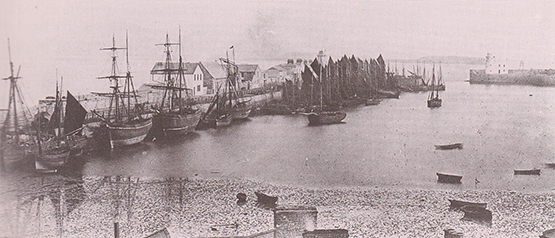
Howth Harbour in the 1870s, when it had become a “Fishing Station”
Much the same thing happened at Dunmore East, which was initially the packet boat port for Waterford, and the local fishermen weren’t really allowed into it at all. But then the advent of steamships meant the packet boats could go straight up to Waterford itself, and after an interval lying idle, Dunmore East also became a Fishing Station. But it was only because nobody else further up the pecking order had a use for it – in those days, fishermen were expected to fend for themselves.
So for thirty years and more, Howth was almost totally devoted to fishing, but in 1875 the famous Judge Boyd – he is referenced in Ulysses – took a lease on the harbourside Howth House which had originally been built as a residence for John Rennie, the engineer building the harbour. The Judge was well got, as his main house was in Merrion Square – it’s now the French Embassy – but as he was something of a maverick, he decided that he’d pursue his sport of sailing through Howth rather than Kingstown.

Judge Boyd was such a noted Dublin character that he was referenced in Joyce’s Ulysses

Thanks to Judge Boyd’s influence, Howth had a government dredger almost permanently on station from 1888 onwards. And for those who would seek further cultural references, the Yeats family lived in the house on the foreshore just to the left of the fishing boat from 1880 to 1882
A maverick he may have been, but he had influence in high places, and when the silting of Howth became even worse in the 1880s, hampering the seasonal activities of the travelling fishing fleets, the Judge saw to it that Howth got its own government dredger as an almost permanent feature.
The trouble is, the fishing was too successful – the herring were fished almost to extinction. By the 1890s, fleets visiting Howth were declining rapidly, but this in turn facilitated the development of the local sailing club, founded mostly by Judge Boyd’s sons in 1895.
However, the old Judge had lost none of his sparkle, for in 1892 he had bought the supposedly out-classed Fife 70-footer Thalia from the Clyde, and proceeded to win races left right and centre with her. Often he helmed her himself, but if he felt like a rest, the talented professional skipper who came with the boat was Owen Bissett, who stayed on in Ireland with such commitment that today one of Howth’s most able sailors, Ross McDonald, is Owen Bissett’s great-great grandson.
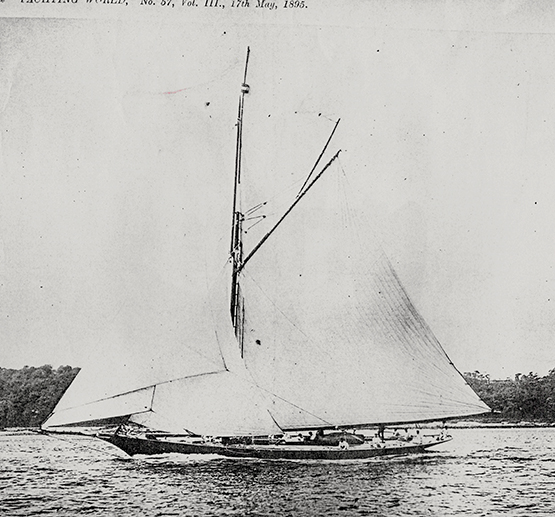
Judge Boyd’s Thalia racing in the Clyde – in Clyde Fortnight 1897 she won 140 pounds in prize money, the third highest in the regatta. Though he raced the boat himself, Judge Boyd also had a professional skipper in Owen Bissett, great great grandfather of today’s successful Howth skipper Ross McDonald
And if you wonder how the Judge managed to keep a large engineless yacht in little Howth Harbour, a yacht whose overall length from mainboom end to bowsprit end was well over a hundred feet, the answer is he treated Howth Harbour as if it was his private marina. After all, it was he who ensured it was dredged, so hadn’t he every right to keep Thalia in a very handy berth inside the nib on the West Pier? And if he happened to omit to retract Thalia’s long bowsprit which protruded well beyond the end of the nib, then heaven help any fishing skipper whose ancient craft managed to get fouled up in this exquisite piece of classic yacht equipment.

Regatta day at Howth, and Thalia in her berth inside the nib on the West Pier
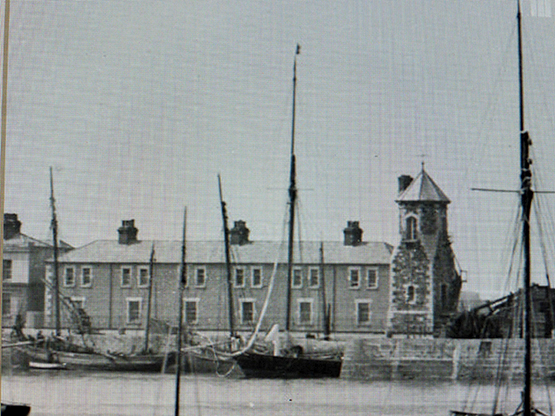
The perfect private berth – Thalia at the West Pier in Howth around 1900
It’s difficult to escape the feeling that the Judge’s four sons thought the old man was maybe a bit over the top, for in their new Howth Sailing Club they promoted the notion that “Small is Beautiful”. When the oldest brother Herbert designed the new one design class for Howth in the Autumn of 1897, the resulting Howth 17s were of very modest proportions, just 22ft 6ins in overall length.
In time, the mighty Thalia ceased to be a feature of Howth Harbour. She was of such a size that the easiest way to lay her up was a winter berth afloat in the Grand Canal basin in Dublin. But as she had been built on steel frames with copper fastenings, she was virtually on fire with electrolysis, and her days were short – by 1910 she had gone.
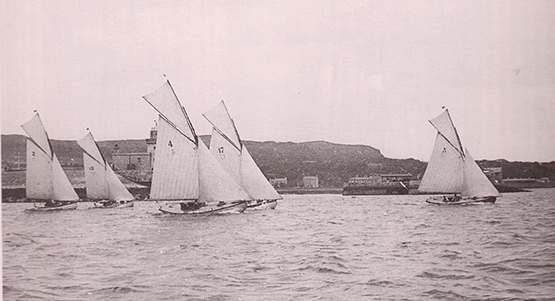
A much more modest proposition – the handy little Howth 17s were introduced in 1898, and they hope to have 18 boats racing this summer

From time to time, the Howth 17s add new boats – this is Erica and Isobel joining the fleet in 1988
The joys of classic yacht ownership…..Pat Heydon working in early March on the re-caulking of Gladys (built 1907), which he co-owns with Eddie Ferris and Ian Byrne. Photo: W M Nixon
But the Howth 17s plough steadily on 118 years later, thanks to a sort of group scheme of mutual help when a boat needs serious work done, with longtime owner Ian Malcolm as the multi-talented core of a sort of men and women’s shed movement with a maritime purpose. The purpose is to get in as much racing as they can, with as many boats as humanly possible. This season they’ll have 18 of them sailing, while a classic boat festival at Howth in early August has already roped in Mermaid Week, and they and the Seventeens will be more than happy to welcome other long-established wooden craft.
As for Howth generally, the inevitable conflict between the needs of fishing craft and the needs of recreational boating were more or less resolved back in 1982, when the recreationals were moved into the eastern part of the harbour with its marina and - in time - a completely new clubhouse, while the western section became a state-of-the-art fish dock with synchro-lift and all the trimmings.
It was a case of good fences making good neighbours, and maybe the harbour users of Howth became too contented, for the powers-that-be seemed to forget that in a harbour set beside a sandy channel through which the tide can flow with some vigour, routine maintenance includes regular dredging.
In The Netherlands, arguably the best-run maritime nation in the world, every harbour is dredged as a matter of routine every four to five years, regardless of whether or not there has been significant silting. It’s just done, and that’s how it is – it’s the Dutch way.
But in Ireland, it seems we have to chivvy the authorities to do what should be a matter of routine, and ultimately it all seems to come back to the door of the Office of Public Works, which despite its name seems to think that it’s activities should be carried out in as private a way as possible. Maybe it should be re-named the Office of Good Works By Stealth, for the word is that Howth is going to be dredged, and it might well be sooner than later.
Meanwhile, the Department of Agriculture & Fisheries have been quietly beavering away providing the small boat fishermen with their own rather splendid pontoon. It’s an extremely fine bit of work, but so far as we know, it is only recently that the notice has gone up telling us what it’s all about.
It’s coming to a harbour near you…….the notice of the new facility was erected without any fanfare...
...and for the time being there’s no news of when the new pontoon will be officially opened
As for actually getting the use of it, the situation is now a bit reminiscent of the 1840s. There’s this really classy and useful bit of infrastructure, just as there was once the unused Howth Harbour back in the 1840s. But nobody is as yet allowed near it. The smaller fishing craft still raft up outside each other, and their crews still have to clamber up the quayside.
There’s probably a perfectly good reason why the new pontoon has not yet opened for business. But as our email enquiry to the Department has gone unanswered, we can only assume that until a new Government is formed and there’s a fully-accredited new Minister ready to sweep out in the limo to perform the opening ceremony with all the attendant pomp and kudos, then this lovely pontoon will continue to float serenely on, just like the Sleeping Beauty.
While Howth’s new small fishing craft pontoon awaits its official opening, its future users continue to raft up alongside each other at the quay. Photo: W M Nixon
Belfast Lough Celebrates 150 Years of Organised Sailing in Style
The development of organised sailing in Ireland seems to have spread northeastwards from the south and southwest coasts. Although the great chieftain Hugh Maguire had a fleet of pleasure vessels including sailing craft on Lough Erne in County Fermanagh in the 1500s, while the noted scientific polymath Sir William Petty found a sailing “pleasure boatte” on Dublin Bay to test his catamaran Simon & Jude against in 1663, it was on Cork Harbour that we find the first formal organisation with the foundation of the Water Club in 1720 writes W M Nixon.
Before the advent of good roads, and long before the railways arrived, Ireland’s myriad waterways and lakes provided the best options for the inland transport both of goods and people, and inevitably some gentrifried working boats were also used for relaxation, and the next club to be formed was Lough Ree YC in 1770. By 1820, the world’s first club specifically organised to provide racing came into being on Lough Erne, then nearby on Lough Gill in Sligo, the Ladies’ Cup was first raced for in 1822, and it still is cometed for today, though now at Sligo YC’s sea base at Rosses Point.
In the pre-famine era before 1845, the relative affluence of the west and southwest of Ireland supported the landed classes in yacht ownership, and a regatta at Kilrush in the Shannon Estuary in 1828 saw the establishment of the Royal Western of Ireland YC, which at its height in 1838 had a fine fleet of 18 cutters – some of quite substantial size - based in Kilrush Creek and spreading outwards to families along the coast such as the O’Connells of Tralee, Cahirsiveen and Derrynane.

The Game Changer. Dun Laoghaire’s first regatta in 1828 set Dublin Bay on course to be the pace-setter in yachting development.
But 1828 also saw the first regatta to be staged at the new harbour of Kingstown on Dublin Bay, and the success of this provided an unrivalled focus for the development of new ideas in sailing not only in Ireland, but at an international level. Whereas other sailing area saw the locations of activity spread across several centres large and small, in Dublin Bay there was just this one big powerhouse of sailing development through which all the recreational nautical energy of the capital city was channeled. The Royal Irish YC came into being in 1831, the Royal St George YC got going in 1838, and soon Kingstown outstripped most comparable centres at home and abroad, particularly in racing development.
Yet at this time Belfast was already the fastest-expanding city in Ireland, and it was moreover a growing centre of genuine wealth-creating manufacturing industries and ship-building enterprises. Why wasn’t Belfast Lough in the forefront of sailing development by the 1850s?
It wasn’t as though there wasn’t a small but time-honoured local recreational sailing tradition on Belfast Lough. During the 1780s and 1790s, Belfast had been a place of liberal ideas and social innovation, and a small group of recreational sailors led by Henry Joy McCracken pioneered cruising from Belfast Lough to the west coast of Scotland and the Hebrides. But then in 1798 McCracken also led the rising of the United Irishmen, and when it was suppressed he was executed by hanging in the Cornmarket in Belfast on land which his grandfather had donated to the town.
Subsequently, the Presbyterian majority in the north turned in on themselves and concentrated on commerce and manufacture and literally minding their own business. But though, as prosperity returned, a small group of McCracken’s former shipmates formed the Northern Yacht Club in Belfast Lough in 1824, Belfast’s rapid industrial expansion made the port very limited as a yacht harbour, thereby limiting their growth.
Belfast Lough may have provided splendid sailing water, but it was very poorly served by other smaller harbours, so the Northern Yacht Club members often found themselves sailing to the more congenial and well-serviced shores of the Firth of Clyde. They soon formed a Scottish branch, and by 1838 the Royal Northern Yacht Club - as it was to become, with an impressive clubhouse in Rothesay - had taken over the few remaining assets of the Belfast Lough branch, and that was the end of any club in the Lough for another quarter century.
Yet any student of sailing history will know that in 1856, Lord Dufferin from Clandeboye near Bangor on the shores of Belfast Lough made a celebrated voyage to the high Arctic with his schooner Foam. And in 1865, one of the most successful racing schooners of all time, the 99ft Egeria, was built for leading Belfast linen manufacturing magnate John Mulholland. So why wasn’t Belfast Lough sharing the sailing fame of other Irish centres such as Dublin Bay and Cork Harbour, which had shown their pre-eminence by staging the world’s first recognisably modern offshore race from Dublin Bay to Cork Harbour in 1860?
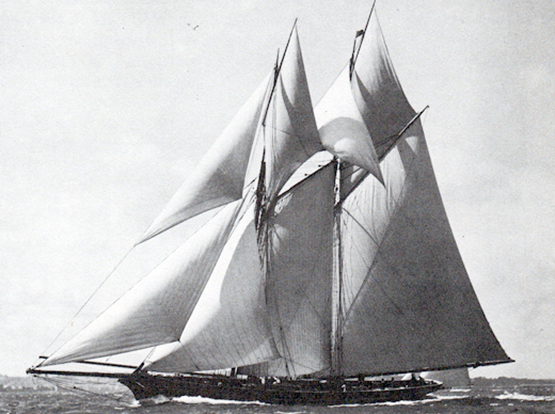
The extremely successful racing schooner Egeria was built for Belfast business magnate John Mulholland in 1865, but she was seldom if ever in Belfast Lough
The simple answer seems to be that in its period of hyper-growth, the business of Belfast was business, and sailing for recreation was not a Belfast business. Those who expected to sail at the highest level did so elsewhere, and once the Belfast to Dublin railway had been connected in 1855, it was as handy for the more affluent would-be yachtsmen to avail of the proper facilities in Dublin Bay rather than risk their yachts on exposed moorings in Belfast Lough, where shore facilities were still woefully lacking.
But in time the rapid rise of an energetic middle class in Belfast saw increasing demand for sailing amenities and events nearer home. We know that a regatta of some sort was staged at Holywood immediately east of Belfast on the lough’s south shore in 1854, and it was at Holywood – despite the little town’s drying anchorage – that the first club since the Northern YC in 1824, the Hoywood Yacht Club – was formed in 1862, and it still exists, Belfast Lough’s senior club.
Then in 1866 a regatta was staged from the only half decent harbour on the lough, at Carrickfergus, and the organisers were pleasantly surprised by the number of boats which turned out, boats whose owners had squirrelled out bits of shelter for their craft in small places like Donaghadee, Groomsport, the tiny drying harbour at Bangor, in the open roadstead off Cultra, in the cleaner parts of Belfast docks, in Carrickfergus itself, and round the corner in Larne Lough.
From this there immediately emerged the Carrickfergus Amateur Rowing & Sailing Club, but mostly to cater for local demand. But soon afterwards in Belfast the Ulster Yacht Club was formed by a group of affluent businessmen, professionals, industrialists and landowners with Lord Dufferin as their Commodore. By 1869 he’d seen to it that they’d become the Royal Ulster Yacht Club, but it was an organisation which was resolutely to function without a clubhouse until 1899, nevertheless growing in prestige with every passing year.
Thanks to that focus of interest through the Carrickfergus Regatta of 1866, 2016 will see double celebrations on Belfast Lough with the 150th Anniversaries of both Carrickfergus Amateur Rowing and Sailing Club (which everyone knows as Carrick Sailing Club), and the Royal Ulster Yacht Club, which since April 1899 has been based in an impressive Arts & Crafts clubhouse on an eminence above Bangor’s waterfront.

The RUYC clubhouse was built in 18 months and opened in 1899 in order to be ready for Thomas Lipton’s first America’s Cup campaign
When the clubhouse was built, the harbour at Bangor was still rudimentary, but the sailing was great. However, since 1984 Bangor Bay has been turned into one of Ireland’s largest marinas, and now RUYC has the berthing facilities and the sailing water to stage major events with confidence.

Befast Lough provides excellent sailing water, but until the marina were built at Carrickfergus and Bangor, it lacked sheltered berthing

Carrickfergus Marina, with the harbour and its famous 12th Century castle beyond
Equally at Carrickfergus they also have a marina – in fact it pre-dates the one at Bangor – but as Carrickfergus was also the base of the extraordinarily productive yachtbuilder John Hilditch, albeit only from 1889 to 1913, one of the main parts of their celebration is going to be a Hilditch Regatta, not just for boats built by him such as Hal Sisk’s famous 1894 Watson cutter Peggy Bawn, the Howth 17s of 1898, and the RNIYC Fairy Class of 1901, but indeed for any classic or traditional craft, as Carrick has always been a spiritual home for the Old Gaffers Association.

Bangor Marina, with Ballyholme Bay beyond
Royal Ulster has meanwhile taken a different track through sailing history, for between 1899 and 1931, it was the club through which Thomas Lipton made his five America’s Cup Challenges, which has tended to obscure the fact that in the 1880s and 1890s, Belfast Lough with RUYC in a key role were setting a fantastic pace in sailing development, as they were trying to get a one design keelboat class going as long ago as 1889, and by 1895 they’d brought the Belfast Lough One Design Association into being with a determined young sailing man called James Craig as Honorary Secretary. Membership of the BLODA was open to any member of one of the recognised six clubs now based round the lough, but young Craig – who later went on to become Lord Craigavon, first Prime Minister of Northern Ireland in 1921 – was realistic in his expectations for the life of a strict one design keelboat class, and he only expected his members to be “in class” for three seasons.
By 1896 they’d the first two boats of a new 15ft LWL keelboat class designed by William Fife, no less, sailing on Belfast Lough, and before the summer was out the signs were good for a significant increase in numbers for 1897. James Craig was insisting the boats be built by John Hilditch, as he was noted for sticking strictly to the plans as drawn by the designer, whereas the builder of the first two boats for 1896, Paddy McKeown in the heart of Belfast, was always trying to improve on the designs, even if they were from Fife.

Regatta day for the Dublin Bay 25s – their design was inspired by the Befast Lough Class I boats.
But events overtook the programme. A group of affluent Belfast Lough movers and shakers decided they certainly wanted a One-Design class to the Belfast Lough ODA rules and designed by William Fife, but they wanted a proper sea-going boats with a cabin, around 37ft in hull overall length, and 25ft on the waterline, and setting a proper gaff rig with a jackard topsail rather than the modest little gunter rig set by the 15ft LWL boats, which were still referred to as Class I.
But as the idea for the bigger boats gained traction, they became Class I, and for a while the 15ft LWL boats became Class II, but after 1900 they were Class III when a 20ft LWL class came along. But meanwhile in late 1896 and early 1897, the Hilditch yard went mad, building nine of the new 25ft LWL boats. Even Lord Dufferin and his friends Lord de Ros and Lord Bangor came round from County Down in April 1897 to the tough town of Carrickfergus to see this remarkable new class of boats being built. And once the 25 footer had their first race off Carrickfergus on May 29th , they swung into action with what today would be called a series of promotional tours, as they did all of Clyde Fortnight after a stormy crossing of the North Channel, and then after being back in Belfast Lough for long enough to race the RUYC regatta, they headed south to Dublin Bay in late July and inspired the creation of the Dublin Bay 25 class.
1898 was when they were in their prime, and by 1899 some owners were aready invoking the “three season” rule to move on, but in fact the class continued to race actively – though sometimes with very depleted numbers – on Belfast Lough until the end of the 1909 season.

John Hilditch was very busy in 1897 – in addition to the Belfast Lough Class I boats, his yard also built this 56ft motoryacht Romance for A J Lepper, for whom he’d built Peggy Bawn in 1894.
We get some idea of the boat-building pace around Carrickfergus in the late 1890s when we realise that in 1897 John Hilditch and his men were also building a 57ft Dixon Kemp motor-yacht, the Romance, for A J Lepper, for whom they’d built Peggy Bawn so well in 1894, and no sooner was the Romance out of the way than they turned to the next job, the building of the first five Howth 17s which their owners were able to sail the 90 miles to their home port in April 1898.
So obviously there’s going to be quite a complicated programme around Belfast Lough in late June and early July this year. And as the Howth 17s are in the unique position of being a Hilditch class which is not Belfast Lough-based, they hope to be able to pay their respects at Carickfergus both to the memory of their builder and to the 150th Anniversary of the Carrickfergus club, while also being able to do full justice to the Classic One Designs Regatta, which RUYC will be staging from Friday June 24th to Sunday June 26th.
The Hilditch Regatta meanwhile is from the evening of Wednesday June 22nd to Saturday June 23rd, when the fleet heads from Carrickferus to Bangor for a sail-past as part of the Royal Ulster events, but with some of the Old Gaffers then returning to Carrick (after due celebrations in Bangor) as the Carrick event is seen partially as a follow-on to the Portaferry Sails & Sounds the previous weekend, which is very much an Old Gaffers event.
In Carrickfergus are (left to right) Nick Massey, Roddy Cooper, Tom Houlihan, CSC Commodore Wendy Moore, and Ian Malcolm. Photo: W M Nixon
But for classes like the Howth 17s, despite their antiquity proper racing is what it’s all about, so I tagged along with a reconnaissance group of Howth 17 eminences when they went up North to suss out the scene this week. And as the group included Nick Massey who re-energised the class when it was going through a flakey period in 1972, Ian Malcolm who is playing a key role in the class’s current revival such that they’ll have eighteen boats racing this year, Roddy Cooper who owns the Hilditch-built Leila, and Class Captain Dr Tom Houlihan, you can be quite sure there wasn’t a dull moment.
First call was with Wendy Moore at Carrickfergus, where she’s Commodore for the 150th as the club settle into the new clubhouse after a disastrous fire three years ago, and as she’s also the Marina/Boatyard Manager and the newest addition to the ranks of owners in the local thriving Ruffian 23 class, everyone was on the same wavelength.

You’ll always find it’s now in a carpark….Roddy Cooper and Ian Malcolm stand on the spot where their Howth 17s Leila and Aura were built in 1898, with Carrickfergus Castle in the background. Photo: W M Nixon
Then we swung by Royal North of Ireland Yacht Club at Cultra on the south shore of the lough, home to the Hilditch-built Fairy class against whom the Howth crowd regularly have inter-club races, and fortuitously met up with Northern Ireland Old Gaffers Association Chairman Gary Lyons for some very high-powered info exchange. As a result we round out this week’s blog with a photo which does justice to the Portaferry Sails & Sounds which he is organising in June.
Then on in haste for a sailing business lunch (delicious) at Royal Ulster YC with Vice Commodore Myles Lindsay, Rear Commodore Greg Taylor, Honorary Sailing Secretary Robin McKelvey and Press Officer Fiona Hicks, learning yet again that the RUYC clubhouse is such a store of sailing memorabilia that it’s a difffcult to concentrate on the formal agenda, but I think the Howth men and the Bangor men understood each other very well indeed.

Myles Lindsay, Vice Commodore RUYC

Robin McKelvey, Honorary Sailing Secretary RUYC
The RUYC people have a lot on their plate, for no sooner is the Classics Regatta out of the way than they gear up at the beginning of July for an assembly in Bangor of cruising boats from the ICC, the RCC, the OCC, the CCC and other associated organisations, followed by a 150th Anniversary Cruise-in-Company along the Antrim coast and on to the West Coast of Scotland and the Hebrides.
But for the recce group from Howth, now it was down to Bangor Marina where manager Kevin Baird couldn’t have been more obliging, but the Howth 17 men all fell in love with the classic ketch Morna berthed right next to the marina office, so Fiona and I had to speed them on their way to the exhibition of 150 Years of sailing in Bangor Museum.
The classic ketch Morna in Bangor Marina. Photo: W M Nixon
And then after that, duty done and work completed, I took them for the treat of the day, down among the hidden places of Strangford Lough to meet up with Kenny Smyth at his boatyard, which for any one who is into classic, vintage or traditional boats is heaven on earth. And of course it emerged that Kenny the King of the River Class, Whiterock’s historic Mylne-designed premier fleet, has recently become Commodore of Strangford Lough Yacht Club. So we headed for home into a gorgeous sunset having notched up two Commodores, one Vice Commodore, one Rear Commodore, one Chairman, one Honorary Sailing Secretary, two Marina Managers and one Press Officer. And if that’s not a good day’s work on the diplomacy and negotiating front, then I don’t know what is.
The eternal enthusiast. Kenny Smyth of Whiterock runs a boatyard, he is also Commodore of Strangford Lough Yacht Club, he is River Class champion, and he just loves talking about boats night and day. Photo: W M Nixon
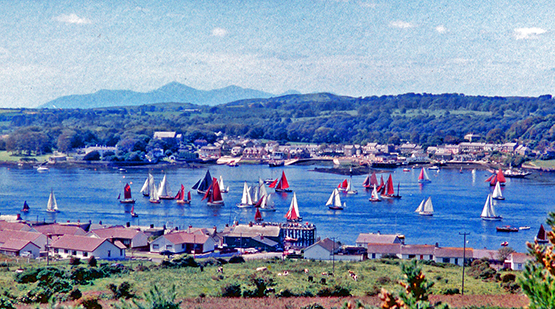
The promise of summer – the classic and traditional season in the north starts with Portaferry Sails and Sounds on June 16th.
'WhatsApp' with Dublin Bay Sailing Club Lasers for 2016?
Communications in Irish sailing clubs and classes are changing. For example, this year the Lasers on Dublin Bay SC will only be via an opt–in 'WhatsApp' group organised by Paul Keane from the Royal Irish YC.
DBSC racing for the growing class will be the same format as last year; Tuesdays, two races each night, Full rigs and Radials (times adjusted) and attractive entry fees of €163 or €107 for under–25s.
The aim is to build on last year’s 30 entries and regular turnouts in the teens. First race is April 26, 7pm first gun.
As Keane commented on Afloat.ie: 'Credit where credit is due. The Dun Laoghaire Moths have been using WhatsApp since they started their fleet and the Cork Monkstown Laser Fleet also use it to great effect. I am lucky to be included on both of these conversations and what continually strikes is the constant friendly chat. Setting up a group for the Leinster Lasers and trying something new seemed a simple thing to do. I hope now we can re-create some of the camaraderie I've been privy to in the other fleets and see bigger turnouts at all of our events'.
As well as Tuesday nights there is four Waterfront club regattas on Saturdays in late June/early July as well as two other key dates for Bay Laser racers:
May 21/22 Laser Master (Over 35) Irish Championships, National YC.
July 16/17 Laser Leinster Champs, also NYC.
email Paul your mobile number at [email protected] for DBSC Laser updates. Nightly results will be available on Afloat.ie in our dedicated DBSC results section.
DBSC Spring Chicken Racing Cancelled in Breezy Conditions
Winds gusting to over 40 knots led to the cancellation of the second race of DBSC's Spring Chicken series on Dublin Bay this morning.The 46–boat fleet will gather again next Sunday for the six race warm-up event.
The DMYC Frostrbite series for dinghies was also blown out at Dun Laoghaire this afternoon.
DBSC Spring Chicken Series Results, Starts & Handicaps
After a tricky end to the first race where a 1720 had to be rescued from the surf on Dublin Bay, the second race of the Rathfarnham Ford sponsored DBSC Spring Chicken series starts this Sunday morning.
Downloadable below are last Sunday's results along with Handicaps and Starts for next Sunday's 46–boat fleet.




























